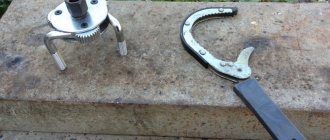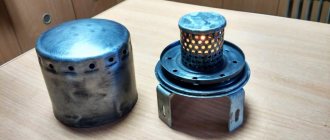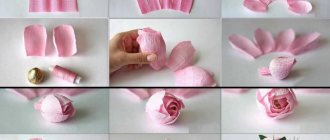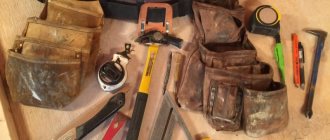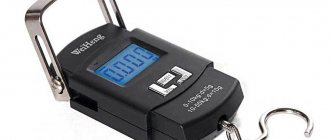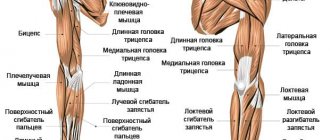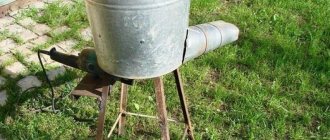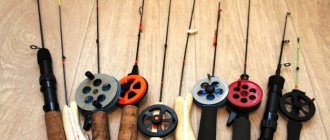Dear visitors of the site “ Samade Friend ”, from the material presented you will learn how to make a universal key yourself from a bicycle chain, a bolt and three nuts with your own hands. Step-by-step photos of assembling the wrench are presented and so off we go... Many of you have probably encountered such a problem... when the edges on a nut or bolt being turned off are a little knocked off and a regular wrench simply turns without performing its function. This can be solved with the help of a homemade chain wrench that works in compression, that is, the stronger the handle of the key, the stronger the chain will be clamped and thereby unscrew even the most eaten nut or bolt.
To make a universal key you will need a piece of a bicycle chain, two nuts and a bolt. We screw the nuts onto the bolt and weld a piece of chain to them so that we get a grip and weld it to the other side of the nuts. Next, we put the chain on the nut or bolt that needs to be unscrewed and tighten the bolt, thereby tensioning the chain, everything can be unscrewed)
Materials
Tools
Step-by-step instructions for assembling a universal key with your own hands.
And so, the necessary parts to assemble the key. Two nuts are screwed onto the bolt. We measure the chain, namely how much is needed from nut to nut. We make a mark in the place where the chain should be riveted. We clamp the chain in a vice and cut off the rivets using a grinder. We knock out the rivets. Next, the chain is welded first to one nut. Then it is tensioned and welded on the other side of the nut. Scale and excess metal are removed using an angle grinder (grinder). Then unscrew the bolt and loosen the chain to the required diameter. We insert the nut and tighten the bolt along the threads, thereby tensioning the chain and clamping the resulting connection. Let's test the key in action. We consolidate the material covered by watching the video. Enjoy watching)
Purpose of the puller
According to the car's operating manual, problems with how to unscrew the oil filter yourself cannot arise in principle:
- When changing the oil, a new filter is installed;
- the sealing rubber must be lubricated with lithol;
- tighten the consumable element by hand;
- tighten 1/3 turn with slight force.
In this case, the rubber sealing ring does not stick to the ebb of the engine housing; the filter can be removed by hand without a puller. In case of severe contamination of the housing, use a piece of sandpaper - the hand does not slip, the abrasive material ensures reliable grip of the palm on the filter housing.
A piece of sandpaper for unscrewing the oil filter
These requirements are often violated by the users themselves:
- there is no lubrication of the rubber ring; at high pressure and temperature it loses elasticity and sticks to the filter housing and the engine seating surface;
- It is not clear for what purpose the car owner tightens the thread with both hands, tightening it and flattening the rubber seal.
Even in this case, you can try to do without a puller:
- tap the rim in a circle on the side of the sealing ring to ensure its mobility relative to the filter housing or the ebb of the groove of the seating surface;
- pierce the rubber seal with a narrow screwdriver, separating it from the low tide side.
Tapping the rim in a circle
In all other cases, you have to use special devices to twist this consumable item. Since access to the filter is difficult, and its outer size differs on different machines, the question of which puller is better, in principle, does not make sense for the following reasons:
- there are turnkey or head pullers with their own handles;
- some tools are made for a specific filter diameter;
- other pullers have adjustable gripping devices of several sizes;
- Universal sliding devices are suitable for any passenger car filters.
Purpose of the oil filter puller
To purchase or independently manufacture a specific puller model, you should familiarize yourself with the design of each of them.
Differences between a screwdriver and an impact driver
Many people mistakenly think that an impact driver is a good alternative for a screwdriver, but this is deeply misleading. Both devices differ significantly from each other not only in design properties, but also in their operating principle. The screwdriver transmits impact force in a plane perpendicular to the axis of rotation. By the way, this distinguishes it from an impact drill, which is capable of creating shock loads along the axis of rotation. True, a screwdriver only facilitates the process of unscrewing and tightening an already rotating screw.
The functionality of such devices is completely different:
- Impact screwdrivers perform the initial “breaking” of a screw that has become too “stuck” to the connection.
- An impact-type screwdriver reduces the required pressure on the tool when performing the task.
After studying all the features of the tool, be sure to watch the corresponding training videos that will allow you to decide on a specific model from a specific manufacturer. In this case, you will be able to make the right decision and purchase a truly useful and reliable tool that will serve you for a very long time.
Read also: Timing kit sat reviews
Why might this be needed?
Easy and quick: how to make a cube out of paper
Car manufacturers recommend changing the engine oil every 15 thousand kilometers. Under difficult operating conditions, for example, when traveling with a trailer, the lubricant is changed more often. When changing the oil, it is advisable to change the oil filter.
Many car enthusiasts do not understand the reasons for replacing the oil filter when the lubricant is changed. The engine is the heart of the car; it is subject to the greatest wear and tear, since it bears the main load. The engine fluid being poured contains foreign particles that have a bad effect on the operation of the engine. An oil filter is designed to filter out these particles. The more it is worn, the worse the quality of the lubricant becomes, and this, in turn, affects engine wear.
Structure of the filter element
It is impossible to determine the suitability of an oil filter by appearance. It is also difficult to draw conclusions about the need for replacement based on mileage. The filter element works constantly, even when the engine is idling, so its wear depends not on mileage, but on engine hours. Some drivers, when changing the oil, neglect to replace the filter element, considering it unnecessary.
When choosing a replacement product, it is important to focus not on its appearance, but on its content. Drivers with an aggressive driving style are better off installing expensive products.
This is due to the fact that when driving fast, hard braking or accelerating, the engine requires a large amount of oil. Expensive filters have synthetic elements that can withstand loads and high temperatures well, allowing the oil to pass through quickly. Analogues have felt-based elements through which the lubricant passes longer than through synthetic material. These products are suitable for lovers of a quiet ride.
What to do next?
Before screwing in the new device, the installation site should be wiped with a rag. Otherwise, dirt or foreign components will get into the motor fluid, which will affect its quality.
Screw in the new filter without a key
The installation process is as follows:
- The seat of the device is cleaned of dirt.
- About 150 grams of motor fluid is poured into the oil filter. This is done to lubricate the rubberized gasket on the device, as well as to prevent the filter element from sticking in the future.
- A new filter is being installed. It must be carefully placed on the thread so as not to damage it.
- The device twists without any effort. There is no need to use a puller during installation, otherwise dismantling during the next replacement will cause difficulties.
- After installation, start the engine and warm it up to operating temperature. Assess the condition of the filter device and make sure that no oil is coming out from under the part. Fluid leaks are associated with a faulty filter or poor installation. In the first case, the part must be replaced, in the second, it must be tightened.
What do you need to know about other pullers?
How to make a greenhouse from window frames with your own hands quickly and easily
The chain oil filter puller, depending on the design, allows you to unscrew and tighten filters with diameters ranging from 60–140 mm. It consists of a handle and a chain attached to it at one end, which serves as an adjustable grip. Most pullers are equipped with a single-row chain, but there are also models with a double-row chain. The second end of the grip, depending on the design, can be free or passed through a special groove located in the handle and having a lock.
During the first execution of the puller, before unscrewing the filter, the chain is tightly wound around its body, almost to the end. The remaining section of the grip is attached to the hook on the handle. After this, the puller rests on the filter and acts like a lever. The second version of the tool already has a loop made of chain, which has adjustable dimensions and is immediately thrown onto the filter. After this, pulling the end of the gripper passed through the groove, tighten the loop and press on the tool handle in the desired direction. At the same time, the groove lock securely holds the chain, preventing it from loosening its grip.
Grab with chain loop
Belt pullers have a working diameter range of 25–160 mm. They have a special belt that forms a loop to hold the filter. It can be fixed at both ends in a square steel rod. A belt is wound around it after the loop is thrown over the filter. Then a suitable key is placed on the rod and the cleaner is unscrewed. Another type of puller is similar in design and use to the second type of chain tool.
The operating range of belt filters is one of the narrowest - the difference between the minimum and maximum permissible filter diameters can reach only 30 mm. They use a strip of steel or plastic, fixed at both ends to the handle and forming a loop, the size of which can be slightly adjusted in some designs. After throwing the grip on, force is applied to the handle and it acts like a lever. The tightness of the filter coverage is achieved in some designs by a screw on the handle, and in others - due to natural tension when unscrewing. Most pullers of this type often fail to cope with filters that are too tight.
Belt filter part remover
The tools are sickle-shaped and pliers-shaped and have 2 working curved jaws with notches and 1 or 2 handles. Their working range of grip is also small; in some designs it is adjustable. Work with these pullers as with ordinary pliers - grab the filter, squeeze and unscrew.
A puller with 2 adjustable jaws consists of a thick narrow base plate, a screw and paws with notches on the working part. The threaded ends of the grippers are moved in the longitudinal slots of the base and secured in the desired position with a nut. When you tighten the screw passing along the thread of the hole in the center of the plate, after it is pressed tightly against the filter, the latter is unscrewed.
Types of industrially manufactured pullers
Depending on the design features and size of the filter, pullers of one type or another are used to unscrew it. Their body or base is usually made of steel and is protected with a matte or silver chrome finish. A number of products, if provided for by the design, have plastic linings on the handles, which greatly simplifies the work with such a tool.
Oil filter loosening tool
Almost all pullers allow you to unscrew both oil purifiers (hereinafter referred to as cleaners) and oil cups - filter casings with a replaceable insert. All pullers can first of all be divided into universal ones and those designed for unscrewing filters of only one diameter or type.
Among the first, the following main types are distinguished:
- crab;
- belt;
- chain;
- tape;
- sickle-shaped and tick-shaped;
- with 2 adjustable grips.
Puller with 2 adjustable jaws
Their versatility is relative - not every filter can be unscrewed with them. Firstly, because they are designed for a certain range of diameters of cleaners, and for some pullers it is quite wide, while for others it is not very wide, and secondly, because of their own design features and dimensions. After all, the location of the filter, as well as the accessibility of the filter, differs on different cars, and therefore it will be easy and simple to work with any tool in one engine compartment, but perhaps completely impossible in another.
Only one type of tool is classified as narrow-profile - cup oil filter pullers. They received this name for their appearance, reminiscent of the kitchen appliance of the same name.
Do-it-yourself universal key made from a chain and bolt
11 ways to remove old wallpaper from walls quickly and easily
Dear visitors to the Labuda Blog website, from the material presented you will learn how to make a universal key yourself from a bicycle chain, a bolt and three nuts with your own hands. Step-by-step photos of assembling the wrench are presented and so off we go... Many of you have probably encountered such a problem... when the edges on a nut or bolt being turned off are a little knocked off and a regular wrench simply turns without performing its function. This can be solved with the help of a homemade chain wrench that works in compression, that is, the stronger the handle of the key, the stronger the chain will be clamped and thereby unscrew even the most eaten nut or bolt. To make a universal key you will need a piece of a bicycle chain, two nuts and bolt. We screw the nuts onto the bolt and weld a piece of chain to them so that we get a grip and weld it to the other side of the nuts. Next, we put the chain on the nut or bolt that needs to be unscrewed and tighten the bolt, thereby tensioning the chain, everything can be unscrewed) Materials bicycle chain nut 2 pcs bolt Tools welding inverter angle grinder (grinder) Step-by-step instructions for assembling a universal wrench with your own hands. And so, the necessary parts to assemble the key. Two nuts are screwed onto the bolt. We measure the chain, namely how much is needed from nut to nut. We make a mark in the place where the chain should be riveted. We clamp the chain in a vice and cut off the rivets using a grinder. We knock out the rivets. Next, the chain is welded first to one nut. Then it is tensioned and welded on the other side of the nut. Scale and excess metal are removed using an angle grinder (grinder). Then unscrew the bolt and loosen the chain to the required diameter. Insert the nut and tighten the bolt along the threads, thereby...
Dear visitors to the Labuda Blog website, from the material presented you will learn how to make a universal key yourself from a bicycle chain, a bolt and three nuts with your own hands. Step-by-step photos of assembling the key are presented and off we go..
Many of you have probably encountered such a problem... when the edges on a nut or bolt being turned off are a little knocked off and a regular wrench simply turns without performing its function. This can be solved with the help of a homemade chain wrench that works in compression, that is, the stronger the handle of the key, the stronger the chain will be clamped and thereby unscrew even the most eaten nut or bolt.
To make a universal key you will need a piece of a bicycle chain, two nuts and a bolt. We screw the nuts onto the bolt and weld a piece of chain to them so that we get a grip and weld it to the other side of the nuts. Next, we put the chain on the nut or bolt that needs to be unscrewed and tighten the bolt, thereby tensioning the chain, everything can be unscrewed)
Materials
Tools
Step-by-step instructions for assembling a universal key with your own hands.
And so, the necessary parts to assemble the key.
Two nuts are screwed onto the bolt.
We measure the chain, namely how much is needed from nut to nut.
We make a mark in the place where the chain should be riveted.
We clamp the chain in a vice and cut off the rivets using a grinder.
Next, the chain is welded first to one nut.
Then it is tensioned and welded on the other side of the nut.
Scale and excess metal are removed using an angle grinder (grinder)
Then unscrew the bolt and loosen the chain to the required diameter.
We insert the nut and tighten the bolt along the threads, thereby tensioning the chain and clamping the resulting connection.
Let's test the key in action.
We consolidate the material covered by watching the video. Enjoy watching)
Materials:
The process of making a homemade product is shown in the photo.
From the profile pipe we saw off two identical sections 20 - 30 cm long.
We cut out two rectangular blanks 25 x 50 mm from sheet metal.
Then the cut metal rectangles need to be welded to one profile on both sides.
We clean the welding seams.
We drill holes in the plates.
We insert the second profile and drill a hole through it, the distance between the profiles should be approximately 4 mm.
We take out the profile and cut off the corner.
We fasten the pipe with a bolt and nut.
Insert the timing belt and tighten it.
The result is a universal wrench for unscrewing various parts; using the device is quite simple: put a belt on a nut, tighten the belt, clamp it and unscrew it.
Source
Where can I use such a universal key?
This tool can be used in many jobs. If the length of the chain allows, it can be used to unscrew the oil filter in a car. And in general, it is convenient to use it in hard-to-reach places where it is not possible to work with a gas or adjustable wrench.
There is another option for manufacturing a similar tool, where only one side of the chain is welded to the nut. At the opposite end of the nut, a hook is welded to which the chain will cling. In this case, a longer chain is used here. This allows you to adjust the diameter of the circle depending on need.
But even the simplest version of a universal tool, discussed today, allows you to perform various jobs that are inaccessible to a regular key. And you can start checking the functionality of the device from the same bicycle frame from which the chain was removed. For example, you can try to unscrew the pedal carriage nut.
PHOTO: YouTube.com The key fits perfectly under the nut, while clamping it as tightly as possible
Interestingly, we even managed to tighten the carriage nut a little, despite the fact that the bike had been lying in a damp attic for a long time.
Another advantage of the key
Sometimes it is impossible to unscrew plastic parts, for example, when replacing a water filter element. It is clear that the gas wrench is clearly not an assistant here - the pressure will simply crush the plastic. But with our device this can be done due to the uniform distribution of pressure along the entire circumference of the plastic cover.
In general, such a tool is very convenient to use. At the same time, you can use it to unscrew even small nuts. But to unscrew larger, and especially stuck parts, the homemade wrench will have to be strengthened and made more powerful.
PHOTO: YouTube.com This universal tool makes it easy to unscrew even fragile plastic parts
Details about the universal “crab”
The “crab” puller consists of two plates, which are the body, and 3 grippers installed between them. There are notches on the working surface of the paws that prevent them from sliding over the surface of the filter. The grips are controlled by a clamping mechanism located in the middle of the crab body and between the rotary mounts of the legs.
The mechanism itself, like the puller as a whole, is activated by a special key supplied - this is one of the design types - or by an end or cap tool, for which a corresponding tip is provided, extending from the body. The scheme of working with the “crab” is identical to the process of unscrewing the filter with a “cup” puller. You must first attach it to the end of the cleaner. It is in this part of the work that the “crab” is fundamentally different from the cup, which makes it universal. In the initial position, its paws are spread apart and are able to cover the filter with the maximum diameter allowed for its design.
Universal “crab” for removing the filter element
After placing the grips on the smaller cleaner, the clamping mechanism is activated. In this case, the “crab” will be able to grab a filter whose diameter corresponds to the minimum allowable for the puller design. After the paws grab the cleaner, you must continue to work with the key placed on the drive of the clamping mechanism. This will unscrew the filter. Moreover, the stronger the applied force, the more reliable the grip of the “crab” paws will be - slippage is excluded.
Depending on the “crab” model, it can be used to remove and install filters with a diameter ranging from 60–125 mm. This puller, like the “cup”, is very good when working in narrow and confined spaces.
Chain assembly[edit]
When assembling the chain, it is necessary to overcome the tension of the rear derailleur spring, so an assistant will be appropriate here to hold the derailleur (or remove the chain from the system).
Place the chain so that the protruding pin faces your direction.
Grasp the link that does not have a pin protruding from it and guide the chain from right to left through the front and rear derailleurs. The rear derailleur has 2 “holes” next to the rollers that you need to thread the chain through. Connect the ends of the chain at the bottom against the resistance of the rear derailleur spring. Have an assistant hold the switch.
Place the link to be connected in the squeeze, on the stop that is closest to the fixing screw.
When adjusting the position of the chain, move the pin to the clamped pin so that they are coaxial.
Tighten the link with the fixing screw
Attention! Skipping this step may result in broken squeezer. Rotate the handle to press the pin into the link
Constantly monitor the degree of immersion of the pin in the adjacent ones - it should not be completely flush with the cheek, but stick out a fraction of a millimeter
Rotate the handle to press the pin into the link. Constantly monitor the degree of immersion of the pin in the adjacent ones - it should not be completely flush with the cheek, but stick out a fraction of a millimeter.
Remove the chain from the squeezer, check how symmetrically the pin fits
If necessary, adjust its position.
Check the mobility of the assembled link. If it bends tightly, then you need to grab the chain on both sides of the assembled link and forcefully bend it in the transverse direction.
How to unscrew it if it's stuck?
Laying pipes in the bathroom with your own hands
I’ll tell you a few ways that will 100% help you unscrew this element, so here we go:
Trite with your hands. Often you just don’t have enough strength, just call a “more powerful” person and everything can work out. I will say this in 80% of cases they unscrew it by hand. YES, and you need to tighten it again with your hands, tightly! IT'S ENOUGH!
Special key. I already wrote about it once, you can read it here, of course it’s not always at hand, but if you have a friend with a car, he can drive to almost any spare parts store and buy it. I personally even saw it in several supermarkets, the cost is a penny, about 200 - 300 rubles. Everything with it is quite easy and simple, we hook it on and unscrew it, of course, the body of the element will get wrinkled, but actually we don’t need it anymore.
Rope and screwdriver (another lever). Sometimes they also use an old alternator or timing belt. What we do is twist a loop around the filter, tighten it with a screwdriver, tightly. And we try to unscrew it. The main thing is that the rope or belt does not slip.
Next come barbaric but effective methods. The most important thing is that they are dirty, that is, you will get dirty in oil anyway, if you are not afraid, then they are for you.
A hammer and a long, strong screwdriver. Actually, this method is used to unscrew most intractable filter elements. Since the walls of the element are soft, they are usually aluminum, or tin, and other soft metals. It breaks through very easily (just like a tin can). What we do is drive a long and strong screwdriver all the way through, that is, so that it goes in on one side and comes out on the other. And then we unscrew it like a lever. The most important thing is that everything can be done without a special key, and actually using those tools that are always in the garage. The only downside is that your hands are dirty, because some of the oil is always inside.
Hammer and chisel. This is generally the method that they say “ATAS”, there is nothing to explain here, we take a chisel and “fuck” it with a hammer, the most important thing is to hit closer to the bottom, to the place of fastening, and counterclockwise. The case, of course, will be all dented, but the most important thing is to unscrew it. The downside here is not only that you can get dirty, but also that you can hit the engine block with a chisel. I personally recommend the method with a screwdriver, it is still less dangerous.
As you can see, there is nothing complicated, you can do without a special key, just pierce the housing with a screwdriver.
Now we are watching a short video.
And that’s all for me, read our AUTOBLOG.
(17 votes, average: 3.94 out of 5)
How to dismantle different types of chains
All instructions on how to remove a chain from a bicycle describe the same procedure. To perform this you will need a standard set of tools:
- wrench for unscrewing the rear wheel;
- pliers, necessary for holding the pin and segments;
- squeezer – a special device for pressing out pins.
Replacing a damaged, sagging, torn or jumping blade requires removing the chain. There are two ways to perform the procedure. The optimal option depends on the type of link fastening.
Rear wheel wrench
Pliers Squeeze
Without a lock with a squeeze
A squeeze tool, which consists of a metal base and a screw-on bolt, will help you perform the procedure correctly. Sometimes this tool is included with a set of hexagons. Experts recommend taking it with you on the road. The chain without a lock is removed in accordance with the instructions:
- First of all, one or more links are selected for opening;
- the cells are placed on the tool so that the pin is located directly in front of the release axis of the device;
- With careful movements, unscrew the screw and pull the axle towards you;
- The axle is put in place by clamping the links and returning the pin to its original position.
Removing a chain from a bicycle without a lock is quite difficult. If you push the pin all the way out, you won’t be able to insert it back on your own. The mechanism cannot be disassembled without special tools, so it is not popular among cycling enthusiasts.
With a lock
The locking leaf is connected by a special device that can be easily disassembled. To find the fastening, you need to carefully inspect the chain from all sides. The split link is usually stamped with the brand name. You can open it using a screwdriver, pliers, a key with notches or any other tool. The procedure consists of several stages:
- you need to find split links, select one of them;
- the cell is clamped with a suitable tool and careful movements are made to the side;
- The part is removed for repair or replacement.
When there is a breakdown on the road, you don’t always have special tools with you. In such a situation, you can remove the chain and lock from the bicycle using only your hands. The procedure is carried out according to the instructions:
the selected cell is clamped with the thumb and forefinger; shift the metal structure to the side (it is convenient to use ordinary thread for this); the thread is carefully hooked to the edge of the fabric in a pre-selected place, then pulled to the side, moving the mechanism; after this, the failed element on a bicycle without speeds is removed for repair or replacement; if replacement is intended, after removing the old one, the new element is carefully inserted into the common fabric.
If there is a chain with a lock, the bicycle can be repaired without squeezing. Emergency repairs are carried out to avoid the part slipping off or breaking. You can do this yourself without resorting to the help of specialists.
Operating principle of an impact screwdriver
The simplest version of such a screwdriver is made in the form of a special tool with a monolithic core, which begins with a tip and ends with a massive heel in the handle area. This product was in demand back in the days of the Soviet Union.
Modern models are equipped with a hexagon near the tip or on the handle, so they are able to transmit rotational force from the key. To successfully complete the task, it is advisable to use a screwdriver together, since one worker will be able to hold the tip in the screw slot and create torque with a wrench, while the other will strike the back of the handle with a hammer.
True, such a solution has some disadvantages . Among them:
- The need for two partners to work together.
- Lack of conversion of received energy into torque. Hammer blows only unscrew a self-tapping screw or screw, since they are capable of destroying rust and creating a certain vibration. The version of the impact-rotary screwdriver is more advanced, so it can transform the impact force into a rotational movement of the tip, which is very convenient.
In most cases, the term “impact screwdriver” means precisely a modernized solution, since the classic simplest version has long gone out of common use and has ceased to enjoy its former popularity.
In the improved version, the impact-rotating unit is located in the handle, and the sting is fixed on the gear and has characteristic oblique teeth. A clip with counter teeth is used as a handle. Under the influence of hammer blows on the heel of the handle, the clip begins to move along the axis, imparting a rotational movement to the tip through a gear drive.
In this way, a rotation of several degrees occurs, which is quite enough to loosen the protective connection and successfully unscrew the fastener using a conventional tool. As a result, the clip returns to its previous position by means of a spring.
Operating such a screwdriver is not difficult at all. The rotary mechanism is capable of providing a combined translational and rotational force on the screw slot, which is very effective for successfully unscrewing stubborn threaded connections.
What to look for when purchasing
An adjustable wrench is a universal tool with varying jaw sizes. It has a number of advantages:
- it replaces several models;
- if desired, you will purchase a tool with specially shaped jaws;
- There are models on sale with plastic handles, so they are comfortable to hold while working.
There were some downsides:
- since the head of the adjustable wrenches is quite large, it is difficult to work with the tool in hard-to-reach places;
- the sponge is not fixed securely, and it is not easy to unscrew a tightly tightened nut;
- During the operation of the key, the play increases;
- The position of the sponge needs to be adjusted.
Despite all the disadvantages, the adjustable wrench is easy to use, so hurry to get one.
Chain key. Steel pipe clamp
Despite the fairly large variety in the construction market of tools for screwing or screwing together various pipe connections, experts pay special attention to the chain wrench. A chain wrench is a prominent representative of a hand-held plumbing tool designed for installation of pipes or fittings in hard-to-reach places. Such equipment allows you to work in conditions where the use of a standard adjustable or sponge wrench is impossible.
When should you change your bicycle chain?
A good bicycle chain lubrication can significantly increase the service life of the entire system responsible for movement. At the same time, you need to be able to notice the moments when it begins to need maintenance or repair.
Excessive wear on a bicycle chain not only causes constant discomfort while riding, but also causes active deformation of the chainrings. If a worn chain is left unattended for a long period of time, it is guaranteed to lead to the need to replace a whole set of expensive mechanisms.
In order to assess its condition as objectively as possible, it is necessary to look not at the mileage, but first of all to measure the length of all its links. The chain length in normal condition is approximately 305 mm. The reason for its replacement is its stretching to 308 mm or more.
Complete set of bicycle repair tools
An avid cyclist will not get by with a standard repair kit. It is necessary to add more tools to the kit, allowing you to completely repair any breakdowns yourself, as well as improve the quality of the bike. Additional tools include:
- extended set of keys;
- pullers;
- mounting blades;
- wire cutters;
- hydraulic set;
- strain gauge;
- caliber;
- stands.
Now in more detail about each element.
Additional keys
If your bike model has ball bearings, cone wrenches will be a must-have. They are needed for timely cleaning of bushings.
To remove the pedal, a specially shaped wrench is used. It is ideal for road bike models with little clearance between pedal and crank.
Flat and Phillips screwdrivers that are universal for various jobs are also useful.
Bicycle pullers
In order to remove the connecting rod, it is worth purchasing a square puller. Before buying a tool, make sure that the connecting rod is attached using the “square” system. Typically, higher-end bikes may have a different mount and not require a special puller.
Carriage pullers are used to remove the cups that secure the carriage to the bike. Depending on the bicycle model, you need to select a carriage puller with a different spline head diameter.
An important purchase will be a ratchet remover. This is a must-have tool, since disconnecting the ratchet using other methods is quite problematic. The tool is a splined head
The tool is a splined head.
There is also a special cassette remover. To make working with it easier, it is recommended to buy a special whip in the kit.
Wire cutters
Wire cutters are used to repair gear shift cables. Wire cutters have a special advantage over a knife or other tools in the set that can be used for this purpose. They can be used to gently cut through the cable without deforming it. The edges will not be fluffy and the cable will last for a long time.
Stands
In order to independently and easily repair bicycles, it is worth acquiring two stands. You need to take care of buying a rack on which you can put the bike
It will also be important to purchase a special small stand for wheels, which is convenient for straightening the spokes
Types of keys
First, let's talk about special keys with which you can unscrew the filter. The principle is simple - you need to put it on the filter and unscrew it:
As you understand, the moving part is removed and placed on the filter housing. And with a small protrusion you seem to press down on the other side, thereby ensuring a very strong fastening.
Next, simply unscrew the handle, a very simple and effective design. A big plus is that the price is not high, about 150 rubles, it is also easy to throw on, there is no round loop that needs to be tightened
It is worth noting that there are also special pullers; it’s hard to call them keys!
Making a universal wrench: minimum words and maximum photos
To make this fantastically simple tool you will need:
- unnecessary bicycle chain;
- a wooden block of such thickness that you can easily grasp it with your hand;
- a sufficiently long screw with a nut;
- drill with a diameter corresponding to the size of the screw.
From a wooden block we measure a piece with a length slightly exceeding the width of the palm.
Carefully cut off the measured piece.
2-3 cm from the edge we mark a place for attaching the chain.
We select a drill with a diameter corresponding to the size of the screw.
We drill a through hole into which the screw will fit freely and insert it there. Then we take the chain from which our universal wrench will be made, and find a collapsible link in it that allows us to open it.
Use an awl to remove the locking pad, disassemble the collapsible link, and then open the chain.
We put one of the outer links of the open chain on the tail of the screw.
We fix the link with a nut, which we then tighten thoroughly.
And now our universal wrench, which we just intended to buy, is ready. Now let's see how our miracle tool works and how to use it.
Tools
To work with the chain you will need a fairly extensive list of tools. The most important tool in this case will be a special chain riveter - such devices are produced by many companies, so finding one will be relatively easy. The cost of the tool varies between 1000-5000 rubles depending on the manufacturer and the grade of steel used. From some experienced craftsmen we hear that the riveter is successfully replaced with a hammer, chisel and core. This point of view is completely erroneous - it will not be possible to achieve a reliable connection of the chain with their help, and, most likely, it will soon break.
In addition, replacing sprockets and chain will require the following tools:
- Torque wrench with comfortable handle;
- Set of keys and sockets;
- Compact grinder with a diamond blade for metal;
- Lubricant, cleaner and chain cleaner.
It is better not to neglect the selection of high-quality tools, since it will be very unpleasant if during the work the key breaks in your hands and the motorcycle remains half disassembled. Remember that you will have to replace the chain regularly, so it is worth purchasing a quality set once and then using it for several years.
Other replacement options
The men used a variety of available tools instead of the usual wrench.
Pliers
Simple and reliable - tested more than once. Using pliers incorrectly is simply impossible! Grab yourself tightly and twist!
adjustable wrench
Of course, if a master finds himself in such a situation, he may well have an adjustable wrench.
You will only need to adjust it so that the fastener being unscrewed is firmly grasped by the jaws of the key.
Files
Two files will do the job. Their canvases at one edge must be securely secured with wire, tape, a suitable ring, etc.
After this, the files are placed on both sides of the fastener. This is done so that the nut is approximately in the middle of the blades. Holding both handles of the file at the same time, they begin to unscrew.
Small vise
An option familiar to handicraft craftsmen who have small vices. The nut is secured in a vice and then unscrewed.
Calipers
Another alternative option is a caliper. They operate similarly to the options already described.
It is important not to forget about your own safety! If the caliper comes off the fastener, it can cause injury. Sometimes men risk performing the necessary action even with the help of large scissors
They clamp the nut with the handles of scissors
Sometimes men risk performing the necessary action even with the help of large scissors. They clamp the nut with the handles of scissors.
We do not think that this operation should be repeated. Especially if you do not have such experience and you do not feel confident in performing the procedure.
Wooden strip and nylon tape
Not the most traditional way, but why not try it if you don’t have anything more suitable at hand.
A nylon rope (at least 15 cm will be needed) is tied tightly in the middle of the wooden plank. The free edge of the nylon begins to be wound around the nut. Twist the rope until it ends. Now unscrew the bar. Together with it and the nylon, the fasteners will move from place.
How to use an impact screwdriver
To make the unscrewing process as simple and high-quality as possible, it is enough to avoid irreparable mistakes and follow a number of separate rules:
- The fastener is pre-prepared for unscrewing, so it is cleaned of visible rust and wiped with a rag. The joint is then coated with a special chemical, such as WD-40, a highly effective cleaner. Brake fluid and kerosene perform well.
- Next, you need to fix the tip in the slot, maintaining strictly perpendicular placement relative to the screw head.
- Then you should hit the end of the handle with a hammer with approximately medium force.
- The blows are repeated until the screw head begins to move relative to the axis. Try to check the propeller's progress after each blow.
- Unscrewing is completed using a regular screwdriver.
If the tool is equipped with reverse , many experts recommend setting the tightening mode after each movement of the head, repeating the blows several times, and then unscrewing the hardware again. This is explained by the fact that with this approach, rust elements are removed from the threads particularly well.
To avoid trouble, it is recommended to follow safety precautions:
- It is important to first put on good work gloves or gloves on your hands, which will prevent the handle from accidentally sliding during processing.
- Don't put too much effort into your punches. You can get by with a regular hammer weighing up to 500 grams.
- The strikes should remain light. Do not tilt the hammer, as the hammer can easily slide off the screwdriver, which will cause additional problems.
Why do you need a filter puller?
The design and technology for replacing the filter is extremely well thought out and, it would seem, quite simple. With the advent of filters in a non-separable housing, you can change the oil and filter and not even get your hands dirty. But not everything is so smooth. It often happens that the sealing gasket sticks tightly to both the filter housing and the cylinder block. Then it is impossible to firmly grasp the filter with your bare hands, especially in those cars in which there is a lack of free space under the hood.
And so it begins - broken fingers, two hours of wasted time, the oil change celebration collapsed. To do this, or rather, to make the car bring joy when replacing consumables, many use branded pullers for the filter element, and some try to make an oil filter puller with their own hands.
How to remove an oil filter without a puller
After my article - where is the oil filter located , some of my readers and viewers (mostly those who do the oil change with their own hands) began to write - please tell me how to remove this filter element? It turns out that there is a rather big problem when the filter actually sticks to the engine block (or it was tightened too much at the service station). Of course, to remove it, you can buy a special key (it is inexpensive). However, it is not always possible to find it (and ordering online means a long wait). Today, I will tell you how to make it yourself, how and which one to choose in the store. There will be a video version...
The oil filter is not easy to remove, even if it is screwed on by hand. It has a rubber gasket that presses tightly against the engine block and, like a suction cup, pulls the housing very strongly. When the engine is running, oil passes through it and it is even closer to the block. Thus, when the time comes for the next maintenance, you need to change this filter element, but it is not always possible to unscrew it by hand (sometimes it gets so stuck that the housing wrinkles and does not want to unscrew). It is for such cases that a special key was invented.
I would also like to note that buy only original filter elements, otherwise a fake one can ruin your engine. Watch this video here.
If the belt option does not justify itself, we make a chain one
To make your own chain puller, you will need a piece of half-inch or inch used pipe with uncorroded, undamaged walls and a thread at one end. The length of the piece must be no less than the height of the filter. We select a suitable plug for the pipe so that it screws onto its thread. You'll also need a bicycle chain.
Bicycle chain and pipe
We drill a hole with a diameter of 9 mm in the center of the plug. Using a triangular file, we give it a square shape with our own hands. We carry out the processing until the dimensions of the hole are suitable for the ratchet wrench, or more precisely, for its end. The latter should fit into the resulting opening of the plug quite tightly, with almost no play. Screw the plug onto the end of the pipe and tighten it very tightly. To prevent it from unscrewing when using the puller, it is recommended to attach it to the pipe by welding.
As a last resort, you can try to crush the metal at the end of the thread using a dull chisel and hammer, but only carefully so as not to deform the pipe. We make markings on the pipe for drilling holes for the chain. To securely grip the filter, 2 pieces of it installed on the puller opposite the opposite ends of the cleaner are enough. But you can also make a 3rd hole, between the 2 outer ones, for another 1st chain. In this case, the puller will become more versatile, as it will allow you to unscrew filters with different height sizes.
Homemade device for securely grasping the filter
Having threaded a chain through one of the drilled holes in the pipe, we loop it around the filter, trying out how long the pieces will be needed. We measure out enough so that the puller, when unclamped, fits freely onto the cleaner. You can even make some supply of chain length for filters whose diameter is larger than that installed on the car. But we must take into account that it will be less convenient to work with such a puller. Along the measured length, we disassemble the chain into separate fragments - squeeze out the pins and separate the links at this point.
Having threaded the resulting sections through the holes in the pipe, we make loops out of them - we connect the links of the ends and press in the pins. To unscrew the filter, we put the puller loops on it and, if necessary, when the chains are too long, we manually turn the pipe counterclockwise, thereby removing the slack. Then we insert a ratchet wrench into the plug and, with its help, begin to dismantle the purifier.
Having decided to change the oil in their car themselves, many car owners are faced with an unexpected obstacle - the oil filter does not want to be unscrewed by hand.
Everything is complicated by the round shape of the filter element housing, which is impossible to grasp properly. It’s good if there is a car store nearby that sells special pullers of different types (they are chain, screw, end, belt, etc.), but what if there is no way to purchase a key, but you desperately need to remove the filter?
In fact, everything is much simpler than it might seem at first glance: there are several simple ways to remove the oil filter without a key. We will talk about them in detail in this article.
Design Features
Every girl's dream can come true: we make a doll closet with our own hands.
The simplicity of the design of the chain wrench makes it very convenient and quite easy to use. Any of its models consists of a clamping mechanism and a handle. The clamping mechanism includes a chain and jaws bolted to the handle. The main element in the design of a chain wrench is, of course, a monolithic metal handle. At one end of its base there is a threshold that serves as a kind of support for the pipes. There are special notches on the threshold that prevent the held pipes from twisting. The next important element is the chain. During operation, it wraps around the entire diameter of the workpiece. The chain is attached to the base of the key with a clamp that allows it to hold the tension created.
Special jaws and an adjustable flexible chain provide the necessary fixation of the pipes.
Due to the absence of any fixed elements in the design of the key, it is possible to carry out work in confined spaces.
To use a chain wrench, it will be enough if there is a distance between the structural parts and the pipe equal to the thickness of the chain. In operation, the chain encircles the perimeter of the desired product, and the threshold in this case acts as a special obstacle when sliding. In turn, the lock that fixes the chain in a given position prevents the initial grip of the pipe from weakening. Due to the uniform distribution of applied forces over the area of the product, the risk of various deformations or damage is eliminated.
The principle of operation of a chain wrench is as follows: a chain attached to the handle is thrown over the pipe and tightened tightly, pressing the jaws directly into the material. Then, when force is applied (pressure on the end of the handle), the key turns in the required direction. At the same time, the serrated ends of the “cheeks” roll over the product, ensuring its maximum clamping with subsequent self-braking. The chain in this case acts as a fixing element. Usually it comes with a reserve and can be easily changed if necessary.
Working with a chain wrench is simple, but you should remember a few simple rules:
- thoroughly clean the teeth of any debris that has gotten into them before and after finishing work;
- the use of any spacer materials between the pipe and the chain is strictly prohibited;
- You should not extend the wrench lever with additional pipe sections. This may break its handle.
This tool must be used with caution when working with parts with high finishing parameters or with thin-walled pipes. Significant compression can lead to abrasion of surfaces or collapse of the product. The main materials in the manufacture of chain wrenches are aluminum and steel
Keys made from high-strength steel will last a long time. To facilitate the design of the key, aluminum is additionally introduced into the composition, but this does not in any way affect the strength characteristics. Aluminum allows you to reduce the total weight of the key by an average of 40%. Aluminum is often used in the production of handles
The main materials used in the manufacture of chain wrenches are aluminum and steel. Keys made from high-strength steel will last a long time. To facilitate the design of the key, aluminum is additionally introduced into the composition, but this does not in any way affect the strength characteristics. Aluminum allows you to reduce the total weight of the key by an average of 40%. Aluminum is often used in the production of handles.
Bicycle chain parts and necessary tools
Chain wear indicator
: A typical chain wear indicator hooks onto a pin in the chain while the other end is inserted between two pins or rollers. The numbers on the tool will show how worn the chain is and whether it is time to change it.
New chain
: The type of chain depends on the number of speeds of the bicycle. So, for example, if the bike is 9-speed, you need to buy a 9-speed chain. More advanced chains include a special coating that will delay the appearance of rust, or they are already made of stainless steel.
Replacing pins or connecting link
: New chains immediately come with a new pin or special link called a connecting link that connects the 2 ends of the chain together. If you are repairing an existing chain, you will need to buy replacement pins or connecting links separately - they must be compatible with the chain speed and brand.
Squeeze
: If you have a standard link chain, you will need a compatible puller that will allow you to easily remove the old pin and install the new one when disconnecting and joining the chain.
Pliers:
If you have a chain that connects to a connecting link, you will need pliers to make the process of disconnecting and connecting the connecting link easier.
Dismantling
First you need to remove the chain cover and unscrew all the bolts holding the drive sprocket cover.
After removing the plastic covers, attach all fasteners to their original places to prevent their loss. There is always a considerable amount of dirt under the star cover; it is better to wash it using a special spray. After this, rinse the unit with water and gently wipe off any remaining liquid with a non-abrasive cloth. If replacing the sprockets is on the agenda, you need to loosen their fastenings by unscrewing the corresponding bolts. Here you will need help, since access to the rear wheel sprocket bolts is usually blocked by the pendulum and the motorcycle has to be moved back and forth. Now all that remains is to loosen the rear axle nut - however, there is no need to completely remove any fastenings yet! The motorcycle is mounted on the center stand or trolley, after which you need to finally unscrew the rear axle nut and remove the wheel. Having completed this operation, begin to remove the stars, completely unscrewing the bolts securing them.
To significantly facilitate the installation of a new chain, it is worth cutting the existing transmission mechanism. Some motorcycle models have a special device called a Chain Breaker - just lower it onto the chain and clamp it to knock the pin out of it. If it is missing, the chain can be riveted using the punch included in the riveting kit. However, experienced mechanics say that such a tool breaks too easily, and advise first sawing off the pin heads with a grinder. After this, it will be very easy to break the link - if you do not have all the above tools, you can cut the chain with a hacksaw, although such work will take a lot of time.
If you are wondering how to change a chain using a special tool, then you should know that. A bushing for cutting the chain is installed in the riveter's clamping mechanism, after which it is combined with a pin with a sawn head. The clamping bolt is tightened with a pre-prepared torque wrench with a force of 10-12 Nm. All that remains is to insert the punch and screw it in until the pin falls out and the chain breaks.
